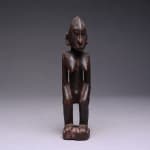African Art / Dogon Female Ancestor Sculpture, 20th Century CE
Wood
26 x 6 cm
10 1/4 x 2 3/8 in
10 1/4 x 2 3/8 in
PF.5823
Further images
Dogon religion is defined primarily through the worshiping of the ancestors. The Awa society is responsible for carrying out the rituals, which allow the deceased to leave the world of...
Dogon religion is defined primarily through the worshiping of the ancestors. The Awa society is responsible for carrying out the rituals, which allow the deceased to leave the world of the living and enter the world of the dead. Public rites include funerary rites (bago bundo) and the dama ceremony, which marks the end of the mourning period. All of these rites involve masking traditions and are carried out only by initiated males who have learned the techniques needed to impersonate the supernaturals. The leader of the Awa society is the olaburu who is a master of the language of the bush (sigi so). The society is divided in accordance with age-grades, ignoring traditional lineage and hierarchical ordering within the village. Small wooden figures, representing both male and female ancestors, are made by specialist carvers who are members of the endogamous smith caste. The figures are "protective spirits," used as the foci of both family and village sacrifices. Upon the death of a relative, the figure is removed from the ancestral shrine and placed next to the corpse for a short period to absorb a portion of the nyama, or spiritual force, of the deceased. The figure is then returned to the shrine, where sacrifices may be made on or near it to secure health, fecundity and an abundant harvests. The figure serves as a line of communication between the living and the spirits of their ancestors, including the founding ancestor of the clan.
This small ancestor figure would most likely have originally stood on a household shrine. The features, such as the arrow-shaped nose, squared shoulders, and parallel planes of the breasts, forearms, and thighs are characteristic of the "classical" Dogon figure style. Overall, this sculpture originally possessed a potent spiritual energy that had the ability to influence and affect the daily life of the deceased’s descendents.
This small ancestor figure would most likely have originally stood on a household shrine. The features, such as the arrow-shaped nose, squared shoulders, and parallel planes of the breasts, forearms, and thighs are characteristic of the "classical" Dogon figure style. Overall, this sculpture originally possessed a potent spiritual energy that had the ability to influence and affect the daily life of the deceased’s descendents.









